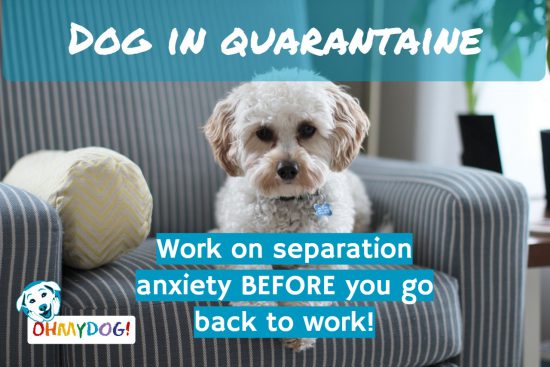Written by Laure-Anne Viselé-Jonkman, zoologist and dog behaviourist
What is so serious about separation problems with dogs?
Separation problems (known as ‘separation anxiety’ in layman’s terms) are a very serious behavioural condition that is also extremely common to boot. Many dogs suffer from it and their owners are completely unaware.
Dogs’ owners think that all is hunky-dory because they see no evidence of destructive behaviour and/or don’t hear a peep from the dog when the leave the house. Interestingly, having even just one of the subtler symptoms listed below is sufficient to get the diagnosis:
- Exaggeratedly happy when you return home, even if you only left for a very short period of time;
- Getting upset when you try to walk to a different room;
- Pacing when home alone;
- Standing by the door, staring, when home alone.
Many owners trivialise the problem as the dog being naughty, and deal with it quite gung ho: “He’ll get used to it”. Separation problems are actually extremely serious and can get worse and worse if not treated.
Aside from the obvious quality-of-life aspects (make no mistake: your dog suffers enormously from it) you can also have to deal with:
- Angry neighbours because of the barking and crying.
- Property damage: “Bye bye, expensive couch!”
- And even huge vet bills: In serious cases, the dog gets so frantic in his attempts to get out of isolation that he’ll seriously injure himself (torn nails, broken teeth, you name it)
- Before you know it: you don’t even dare go to the restaurant with your family anymore.
I hope I have convinced you that separation problems are nothing to trifle with.
What does that have to do with corona?
A known risk factor for separation problems is staying home with the owner for an extended period of time, and then a sudden return to routine isolation as the owners return to office work. This is why we get a lot of clients call us after a pregnancy leave, interestingly.
Now that you are sitting at home, in quarantaine, you are spending your whole day with the dog. This is enough to send even dogs who, previously, had no problem with isolation, off on a spin. It messes with their ability to entertain and calm themselves when home alone.
Our own dog, for example, has never had a problem with isolation. Yet we see that he’s starting to show signs of nervosity when we go upstairs to go to bed at night.

What can I do about it?
- *Go out once, whilst the rest of your family stays in a different room to the dog. Stay away for at least half an hour (if you know your dog can’t cope with this, then skip this step and go straight to step 2)
- Film your dog’s behaviour. If you see the slightest sign of nervousness, then it’s time to do some prevention training.
*Note: Some dogs can cope when someone is in a different room and cannot when they are completely home alone. If that is allowed by the quarantine restrictions in effect in your region, then you’d have to leave the house with the whole family for this test.
The prevention steps are nothing more than (re-)teaching the dog gradually to learn to be home alone, as you would a puppy.
You can find these steps on our puppy page (under ‘Need a little extra help?’). This document is normally reserved for our clients but we want to help in every way we can in these difficult times. We hope you find it educational and useful.
Further reading
- Do you want to follow a puppy course despite the corona measures? You can follow our adapted course (from anywhere in the world). Read more here.
- Do you want to be up-to-date on dogs and corona? Then keep an eye on this article, which we regularly update with the latest scientific and regulatory developments.
